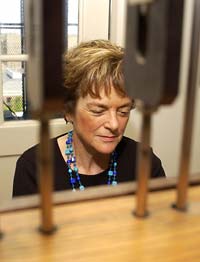She’s no Quasimodo, but she’s been hanging out in bell towers for most of her adult life. Margo Halsted, associate professor of music (camponology) and official University carillonist, has been serenading the campus and Ann Arbor community from the top of the Burton Memorial Tower on the central campus since her arrival at U-M in 1987, and from the Ann and Robert H. Lurie Carillon and Tower on North Campus since its completion in 1996. Her daily offerings range in musical genres from the classics to “The Victors.”
U-M’s towers are not the only sites for Halsted’s performances. She has performed recitals in all countries with an active carillon tradition and has been a featured recitalist or speaker for five World Carillon Federation meetings. All of this is in addition to her role as a teacher, speaker, jurist, musicologist and consultant.

Halsted, who retires this summer, holds a master of music degree from the University of California, Riverside, and a diploma from the Netherlands Carillon School.
A carillon isn’t an instrument you can pack in a case and tuck under one arm. When Halsted travels to play, she can’t take her instrument with her, so she has to adjust to the instrument itself. Some are 200 feet or more in the air.
The carillon probably is the largest instrument there is, one that has at least two octaves of cup-shaped bells arranged in chromatic series and played from a keyboard that allows variation of touch. Even that keyboard is different from what one generally associates with a piano. Instead of keys as on a piano, the traditional carillon keyboard is made of wooden batons (keys that look much like broom handles spaced two inches apart) but configured like a piano keyboard. Next, throw in some foot action on pedals reminiscent of an historic organ, and you find a musician wholly engaged in striking with fists and stepping on “keys” that will activate the mechanics to move the clappers inside the bells.
“Our (U-M) instruments have 55 bells,” Halsted says. “There are 55 bells at the Burton Memorial Tower and 60 bells at the Lurie on the North Campus. These carillons are ranked second heaviest out of 23 of the world’s heaviest of the 600 or so carillons in the world. Heaviest in this instance doesn’t mean the bells are the heaviest in weight, but the largest judged by the number of bells.”
Thoroughly dedicated to her instrument and its history, Halsted has published articles and two books on the 17th, 18th and 19th century carillon manuscripts from Belgium.
Halsted will premiere a new work dedicated to the Jim and Millie Irwin family, “Suite in Popular Style for Carillon,” 7 p.m. June 23 at Lurie Tower.

